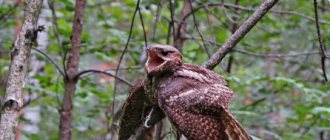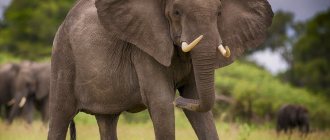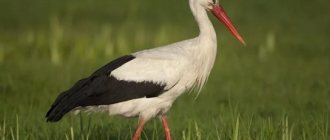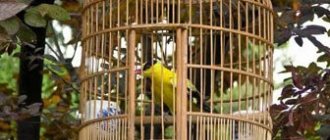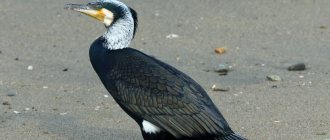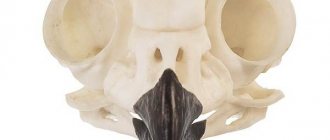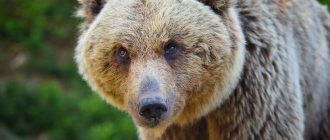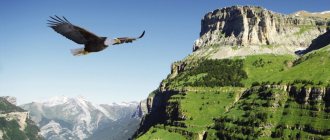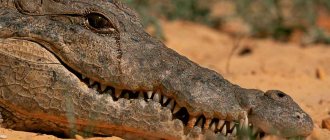Mikhail Kalyakin, Doctor of Biological Sciences, Director of the Zoological Museum of Moscow State University, coordinator of the program “Birds of Moscow and Moscow Region”
Olga Voltsit,
Candidate of Biological Sciences, senior researcher at the Zoological Museum of Moscow State University, coordinator of the program “Birds of Moscow and Moscow Region”
“Kommersant Science” No. 45, October 2022
Rock dove. Photo: Safron Golikov, Kommersant
At the beginning of the 21st century in Moscow, the number of mallard ducks is growing at the fastest rate compared to other bird species, and the drop in the number of sparrows is striking even to ordinary city dwellers who are far from ornithology. Figuratively speaking, Moscow is chirping ever quieter and quacks louder. This turned out to be one of the most noticeable consequences of the large-scale improvement of the capital for the avifauna of Moscow. There are others too.
goshawk
Photo: mos.ru
The goshawk is one of the largest feathered predators in the capital. It is almost twice as large as a crow - the size of an adult can reach 65 centimeters in length. Moreover, female goshawks are much larger than males. These predators do not differ in brightness of color. In adult birds, the upperparts are dark gray and the underparts are light. Light eyebrows are clearly visible above the eyes.
Hawks eat only animal food. In the wild, they hunt jays, ducks and grouse, and can catch squirrels and other rodents. Within the city limits, their usual food is pigeons, crows, blackbirds and other birds. Goshawks hunt from ambush and maneuver well in flight, as they often pursue prey hiding between trees. But these birds almost cannot soar like other hawk-like birds.
Goshawks make their nests in tall trees; pairs usually stay in the same nesting area for many years in a row and lead a sedentary lifestyle.
The goshawk is listed in the Red Book of Moscow, although it belongs to the fifth category of rarity. This means that currently the number and distribution of the species in the capital has increased to a safe level.
In Moscow, goshawks nest in almost all large forest parks - they have been seen in more than 30 territories inside the Moscow Ring Road.
Mute swan (Cygnus olor)
Belongs to the duck family, differs from other swans in its size - it is one of the largest among them. The wingspan of a mute swan reaches 220 centimeters, and its weight is up to 18 kilograms.
It has an elongated body, a very long neck, and an orange-red beak. The main diet consists of aquatic plants and small animals, such as mollusks.
The bird got its name due to the sound that the mute swan makes when irritated. By its nature, it is quite aggressive, always striving to fence off its territory from the invasion of other birds or humans, often with the help of sounds. That is why the typical habitats for the bird are swamps and reservoirs with abundant vegetation. However, the bird is often kept in the reservoirs of city parks.
Interestingly, mute swans are also revered in other countries. For example, in Denmark they are a national symbol, and in Great Britain these birds have a special status and are considered the property of the queen.
Sparrowhawk
Photo: mos.ru
The sparrowhawk is a small predator, smaller than a crow. It hunts mainly tits and sparrows. It attacks from an ambush like a goshawk, but can also hover in the air for a long time, looking for prey in the open space. Therefore, he prefers to settle in forests, near forest edges and meadows.
In Moscow, sparrowhawks lead a sedentary lifestyle. Pairs stay on a permanent nesting site, using the same nests in the treetops for several years. The chicks are hatched quite late; fledglings appear only in early July. With the birth of their young, birds can behave quite aggressively, sometimes even attacking a person who comes too close to the nest.
This species in Moscow has the third category of rarity. Sparrowhawks were observed in the natural and historical parks “Izmailovo”, “Bitsevsky Forest”, “Kuzminki-Lublino”, the Kuskovo Forest Park, in Serebryany Bor and in other natural areas.
Common buzzard
Photo: mos.ru
The common buzzard is a medium-sized predator. The color of its plumage is quite varied: from brown to grayish; below the body is lighter and motley. Stripes are clearly visible on the underside of the wings and tail.
You can distinguish the common buzzard from other members of the family during flight. When a bird soars for a long time, you can notice that its tail is wide open and its wings have a rounded shape.
The unusual name of the predator comes from the word “moan.” In flight, the bird makes a drawn-out sound with nasal “moaning” notes. Breeds in forests, near open spaces. Buzzards feed on small rodents and sometimes amphibians.
This is a migratory species, so buzzards almost never nest in the capital. For them, the city is a transit point; here they stop to rest. In the Red Book of Moscow, birds have the first category of rarity.
In recent years, birds have been spotted in the Kuzminki-Lublino park. And in the Bitsevsky Forest, buzzards can be consistently observed twice a year - in spring and autumn. In the territories of the TiNAO, the buzzard is more numerous, where its rarity category rises to third. And already in the Moscow region this species is considered the most numerous of birds of prey.
Constantly nest in the Moscow region
Black-necked and red-necked grebe
These birds of the Moscow region are similar, only one has a red neck, and the other has a black one. The birds belong to the grebes family, a genus of grebes. The point is not in the toxicity of birds, as is the case with mushrooms, but in the unsightly appearance and specific taste of the meat. Representatives of the species have red eyes, a disheveled appearance, the color is dominated by black, gray, brown
The size of the toadstool is about 30 centimeters, weighing 300-500 grams. You can see birds on the water. Grebes rarely go to land because they have difficulty walking. The feet of birds are located non-standardly, closer to the tail. The body outweighs. Grebes are comfortable afloat.
The toadstool got its unsonorable name for the specific taste of the meat, which smacks of swamp mud.
Greater and lesser bitterns
In the photo both birds of the Moscow region are similar. Assessing the scale of the surrounding feathered objects, you realize that one bittern is much larger than the other. The small one does not exceed 36 centimeters in length and weighs about 140 grams. A large bittern reaches 80 centimeters and weighs about 400 grams.
Both bitterns are herons. Belonging to the family is determined by the structure of the body, for example, long legs, neck, beak. Like other herons, bitterns stay close to water and like to hide in reeds and reeds.
The color of bitterns is dominated by brown-gray tones. Among the representatives of the order Acioriformes, a small species stands out. Males and females are colored differently. The former have a creamy-white back, head and neck, and a black-green cap. Females have a brown back and a buffy head and neck.
The small and great bitterns differ from each other only in size
gray heron
Among the herons, one of the largest. The bird's body length is 1 meter, its wingspan reaches one and a half. The bird weighs about 2 kilograms.
The color of the bird is blue-blue. There are off-white markings on the abdomen, neck and head. The feathered beak is pink. The same color is on the top of the legs. The bottom of the limbs is gray.
White stork
White bird is not 100%. There are black feathers along the edges of the wings, and the legs and beak of the bird are pink-red. The animal weighs about 4 kilograms. The wingspan of the white stork is 180 centimeters. The height of the bird is approaching 130 centimeters.
It is not for nothing that storks have become a symbol of childbirth. Birds of this species are strong in family life. Once a nest has been built, storks restore it year after year, pass it on to their children, and then to their grandchildren. In Germany, a case of storks using a nest was recorded for the 381st year.
White stork
Mallard
The most common of ducks, settling in any reservoir with shallow areas and calm currents. Mallards often coexist with humans, settling on city embankments and country ponds.
Noticing this, man began to domesticate birds. The Greeks were the first to domesticate mallards in the early 5th century BC. However, most of the population remains wild.
The body length of the mallard does not exceed 62 centimeters. The maximum wingspan of the bird is 1 meter, and its weight is 1.5 kilograms. Usually the weight of the animal does not exceed 1 kilo.
Teal-whistle
This is also a duck, but the smallest in the family. The bird weighs no more than 500 grams. The teal also differs from other ducks in its pointed, narrow wings. This allows the bird to fly vertically. Other ducks rise into the air smoothly.
The color of teals is gray-brown. The heads are completely brown with emerald stripes running from the eyes to the neck.
In the photo there is a teal whistle
Tufted duck
This is a medium-sized duck, up to 47 centimeters long, weighing up to 900 grams, with a 70-centimeter wingspan.
The black duck has distinguished itself in its ability to dive, diving to 5-6 meters. Most ducks are limited to 3-4. The crested species lasts underwater for about 30 seconds. By the way, the tufted duck is named due to the brush of black feathers that descends from the head to the neck. The latter is also black, like the back and tail. Against this background, the white sides and beak stand out.
The blackbird is one of the few birds capable of diving to great depths.
Common Buzzard
A medium-sized representative of accipitridae, 50-60 centimeters in length. The weight of the bird ranges from 400-1000 grams. The wingspan of the honey beetle is 120-150 centimeters. However, it is rare to see a bird in all its glory. Most of the time, the hawk sits on trees and the ground, where it feeds on hymenoptera and their larvae.
Eating fruits does not fit with the image of a bird of prey. However, the honey buzzard does not disdain berries. Birds eat them in winter, when getting insects becomes a problem.
Black kite
It also belongs to the accipitridae and, like the honey buzzard, reaches a kilogram body weight and 60 centimeters in length. The wingspan of the bird is 150 centimeters.
The kite does not live up to its name, since in reality it is more brown than black. However, when the birds are in a flock, the colors thicken. It is difficult to find black kites alone. Representatives of the species gather in large communities, building nests at a distance of 100 meters from each other.
Meadow and Marsh Harrier
Like bitterns, they are similar in appearance except for size. The marsh harrier reaches a length of 54 centimeters and weighs more than 500 grams. The meadow species is the smallest in the genus, weighing no more than 300 grams. The length of the bird is up to 43 centimeters. Instead of a white uppertail, the meadow bird has a gray one, and there are black stripes on the wings.
The voices of harriers also differ. The marsh one shouts “kuak-kuau”, and the meadow one “pirr-pirr”. Also, the smallest of the harriers has narrow and pointed wings. In other birds of the genus they are wide.
Listen to the voice of the marsh harrier
Voice of the Meadow Harrier
Meadow Harrier
Pictured is a marsh harrier
Goshawk
The largest of the hawks. These birds of prey in the Moscow region reach a length of 70 centimeters. The wingspan is 120. The bird weighs 1.5 kilograms. Females are larger than males.
The color of both sexes is the same. The front side of the feathers is brown, and the back side is white. Accordingly, in flight the hawk looks light from the ground.
Humans have domesticated goshawks for falconry. The bird reaches its prey either in the sky or in dense thickets on the ground.
Sparrowhawk
This type of hawk hunts quail. Several dozen of them are mined per day. If the hawk is free, it prefers to catch tits, sparrows, and small rodents. A sparrowhawk needs about 100 grams of meat per day, respectively, 2-4 small birds.
The size of the sparrowhawk cannot be called large either. The animal weighs about 300 grams, reaches 40 centimeters in length, and spreads its wings by 70.
Greater Spotted Eagle
A large predator, weighs 2-4 kilograms, reaches 80 centimeters in length. The wingspan of the bird is almost 2 meters. The color is dark. There are single white streaks on the wings, neck, and chest.
The spotted eagle is considered one of the most intelligent birds of prey; it shines in films and in circus arenas. Just by the look of the animal it is clear that you can find a “common language” with it. The spotted eagle looks insightfully, thoughtfully.
Spotted eagles are easily tamed and find common language with people
Merlin
Representative of the falcon family. The bird's body length is 30 centimeters, and its wingspan is 70. The animal weighs no more than 300 grams. Females are smaller - up to 240 grams. Representatives of both sexes are colored gray. It is composed of whitish and brown-black feathers.
Male merlins are caring partners and fathers. Returning first from warm regions, the males set up a nest. Once the females lay their eggs, their partners help incubate them. Merlin chicks that have already hatched are fed equally with their mothers.
Quail
Papyri that have survived from the times of Ancient Egypt indicate that the builders of the pyramids were fed with quail meat. This is the first mention of a bird of the Galliformes order of the partridge subfamily.
Quails, both wild and domesticated, are small. The birds weigh about 100 grams and are 17 centimeters long. The coloring of the birds is protective, brownish-red. Granivorous quail need to remain undetected when a predator is nearby.
Gray crane
Its wingspan reaches 240 centimeters. The bird's body length exceeds 1 meter. The birds weigh at least 3.9 kilograms. Usually it is 5-6 kilograms.
Representatives of the species, like swans, are known for being faithful to their partners. It’s not for nothing that pure, sincere love is called the crane’s song. However, cranes are also known for dancing. Their birds arrange themselves every spring, coming out to the fields, both old and young.
The animals jump, throw various sticks and pieces of grass into the air, demonstrate short runs, and flap their wings.
Robin
Otherwise it is called a robin. The bird is classified as a member of the flycatcher family. It is easy to guess that the animal feeds on insects. The bird cannot hunt large game because it is small. The body length of the robin is 14 centimeters. The robin weighs approximately 20 grams.
The robin is attractive in appearance. The breasts and sides of the birds are bluish. The rest of the plumage has an olive tone. The birds' bellies are white, and their heads and throats are red. This is a bright spot, like a berry. That's why the bird is called a robin. By the way, she sings melodiously and is often kept in cages.
Listen to the singing of the robin
Black kite
Photo: mos.ru
The black kite is a large bird with dark brown, almost black feathers. The kite can be easily distinguished from other predators by its characteristic forked tail. Migratory bird. Like many other birds of prey, it tries to stick to one nesting site for several years in a row. Kites settle in areas of the forest that are located near open spaces, usually near water bodies.
Birds eat small mammals, amphibians, fish and invertebrates. A significant part of their diet also consists of carrion and pasture. In Moscow, black kites are found mainly during the migration period. In the Red Book of the capital, the kite has the second category of rarity.
What is the best way to feed birds in a feeder in winter: food table
A person often feels the desire to take care of “our little brothers.”
If you can't afford to volunteer at animal shelters or send monthly donations to voluntary animal welfare organizations, feeding local birds during the winter season is within your power. By creating a feeder in your yard or on your balcony, you not only provide food for small feathered creatures, you give them a chance to survive, extending their life for several days, weeks, or harsh winters. Of course, you shouldn’t expect gratitude from the little creatures; they will help you at another time - in the summer, when they begin to eat harmful insects (mosquitoes, larvae, flies, ants, aphids and worms), which interfere with growing decent crops. And you must agree that feeding birds will not hurt your pocket, but will bring a pleasant feeling of accomplishment.
IMPORTANT: If you decide to feed birds in the winter season, when it is difficult for them to find food for themselves, it is important to know that in winter their diet is significantly different from in summer. Birds need high-calorie food, but not harmful food (otherwise you will simply kill them).
What you can feed:
| Food: | Peculiarities: | Who eats: |
| Sunflower (seeds) | Seeds should make up almost 70-75% of the total feed (they are filling and high in calories, and contain a lot of fat) | Tits, woodpeckers, sparrows, nuthatches and other granivorous birds |
| Millet | Raw or boiled cereal (without spices and oil) | Sparrows, goldfinches, pigeons, greenfinches and other granivores |
| Millet | Dry food (often sold as pet parrot food in pet stores) | Sparrows, goldfinches, pigeons, greenfinches and other granivores |
| Oats | Raw or boiled cereal (without spices and oil) | Sparrows, goldfinches, pigeons, greenfinches and other granivores |
| Wheat | Raw or boiled cereal (without spices and oil) | Sparrows, goldfinches, pigeons, greenfinches and other granivores |
| Rice | Raw or boiled cereal (without spices and oil) | Sparrows, goldfinches, pigeons, greenfinches and other granivores |
| Meat | Pieces of raw or dried meat, finely chopped. Without any salt or spices! | Tits, nuthatches and other species (crows, jackdaws and magpies may arrive) |
| Salo | Raw lard without salt! It can be strung on a thread and hung | Tits, nuthatches and other species (crows, jackdaws and magpies may arrive) |
| Beef fat or chicken fat | It can be mixed with bread or placed separately in the feeder. Fat should not be salty! | Tits, nuthatches and other species (crows, jackdaws and magpies may arrive) |
| Dried rowan (viburnum, hawthorn) | The berries must be prepared in advance and dried in the fall. They can be placed in a feeder or hung with beads | Bullfinches, waxwings |
| Maple seeds (lionfish) | They should be collected in the fall, when they fall from the trees. In winter, such food is often inaccessible to birds, as it is covered with leaves. Mud and snow | Bullfinches, waxwings |
| Cones | From various types of coniferous trees, should be collected in the fall | Woodpeckers, crossbills |
| Nuts | Any fresh nuts, not salted (like store-bought peanuts) and not roasted | Woodpeckers jays and other species |
| Acorns | Gathered in autumn | jays |
| Corn | Dried | |
| Watermelon and melon grains | Good source of fats and nutrients (prepared in the summer, dried) | Bullfinches, jays, woodpeckers |
| Pumpkin seeds | Good source of fats and nutrients (prepared in the fall) | All granivorous bird species |
| Chicken egg shell | Serves as a good calcium supplement (you can put a piece of natural chalk in the feeder) | For all types of birds |
Winter feeding of birds
Buzzard
Photo: mos.ru
The honey beetle is the rarest of the capital's feathered predators. The Red Book classifies it as category zero. This means that its nests have not been found in Moscow for a long time. However, the bird itself has recently been seen in large forest parks, so experts do not rule out that honey beetles may settle in the city in the future.
It’s easy to recognize him when you meet him. This bird is medium in size. The plumage is brown above, light below and speckled. The head is light gray, the eyes are bright yellow. The grayish tail has three black stripes, which are especially visible during flight.
The honey beetle prefers sparse forest areas bordering river floodplains, large clearings and meadows. It starts nesting quite late - at the end of May, beginning of June. The honey beetle is characterized by unusual mating flights, when the male hovers in one place and flaps his wings over his back. The pair builds a nest at a height of up to 12 meters, always weaving green tree branches into the walls.
The honey beetle got its name for a reason. The basis of its diet is the larvae and pupae of wild bees, bumblebees and wasps. To search for insect nests, birds carefully monitor their flight path from cover for a long time. The dense plumage on the head protects the wasp from attacks by stinging insects. The honey buzzard's diet includes other small invertebrates, as well as amphibians, rodents and birds.
African mocking trills and the oriole paradox
Any day now, lentils, corncrakes, black swifts, green mockingbirds and orioles will arrive in Moscow.
The lentil is a small bird of the finch family, a relative of the finch and bullfinch. The male is completely red, hence the name. Lentils are one of the last to appear in central Russia, because they fly from afar, from Southeast Asia. As the expert said, this is a species that is numerous in Moscow and loves river valleys and abandoned gardens, preferring them to forests: “We have quite a lot of it in the Setun River Valley natural reserve, because there is a suitable biotope there.”
The green mockingbird , on the contrary, loves the forest, especially birch forests. She can be found in Izmailovsky Park. The bird was called the mockingbird because during the winter in the tropical zone of Africa it remembers the trills of exotic birds, and, upon flying back, sorts them out in different ways.
“The oriole is not found very often in Moscow; it is, one might say, a tropical bird. The male is lemon yellow, and the female is green, but despite such a bright color, she is difficult to notice. But it’s easy to tell by her singing: she sings like a flute, very loud. The paradox is that in parallel with a beautiful melody, perhaps one of the most beautiful, the oriole makes a very unpleasant sound that interrupts this melody. This sound is similar to the cry of a cat whose tail has been stepped on,” explained Nikolai Kudryavtsev.
nightingales also arrived in Moscow , whose songs are considered one of the most melodic and loud. Along with nightingales, experts place songbirds, blackbirds, bluethroats and robins among the best singers. If we omit the “cat notes” and take into account only the pleasant part of the melody, the oriole can be included here. In May, birds sing the most and loudest. More precisely, the male half of the feathered population sings: by singing, males attract females and mark their territory.
Marsh harrier
The marsh harrier is a fairly large predator, much larger than a crow. Compared to other harriers, this species has wider wings. The general tone of the birds' plumage is brownish-brown. With age, males become lighter in color, and females develop a yellowish cap and throat.
The marsh harrier prefers to nest in thickets of reeds, cattails and other dense semi-aquatic vegetation. It hunts small waterfowl and their chicks, and can also feed on amphibians and large insects. Belongs to a migratory species.
Harrier
The Hen Harrier is more graceful than the Marsh Harrier. The male is significantly different in color from the female. The general coloration of the male is gray, with prominent black wing tips. The older the male, the lighter his color becomes. Old males are very light, even gray. This is where the expression “gray-haired as a harrier” comes from. Females and young birds are brown.
Photo: mos.ru
Hen harriers nest in open areas with tall grass and uneven terrain. They hunt mouse-like rodents, some reptiles and large insects. Migratory species.
Meadow Harrier
The meadow harrier is similar in size and color to the field harrier, but the male meadow harrier has clearly visible black stripes on its wings.
Compared to other harriers, their flight is usually slower and smoother. In spring, this species arrives a little later than the others and usually returns to its previous nesting sites.
They make nests in open spaces in tall grass, most often in nettle thickets. They hunt mouse-like rodents, some reptiles and large insects. They are also a migratory bird species.
Photo: mos.ru
Coot (Fulica atra)
The coot belongs to the rail family. Most often it can be found in reservoirs. In winter, the Coot, like all migratory birds, leaves the Moscow region. She goes to Asia and Europe, to the sea coasts.
This bird got its name due to its well-recognized appearance - black color, white beak and bald forehead. The size of the coot is similar to an average duck. The wingspan is up to 70 centimeters, weight is 500-1000 grams.
The basis of the coot's diet is plant food, while animal food makes up no more than 10% of the bird's diet. At the same time, the coot obtains food both in water and on land.
Peregrine Falcon
The peregrine falcon is a densely built bird larger than a crow. The species is characterized by a relatively short tail and sharp long wings, which make its flight very swift. The upper part of the body is colored dark, the feathers of the lower part, on the contrary, are light. The head is black, with black oblong “whiskers” clearly visible on the sides.
The peregrine falcon's diet mainly consists of small birds, mainly waders, ducks, thrushes and corvids. Within the city limits he hunts pigeons. It usually dives at prey from above, developing speeds of up to 300 kilometers per hour. In nature, it can nest in old nests of other birds, in rock ledges. However, it is rare in Moscow. Several nests have been observed in buildings and residential buildings.
Photo: mos.ru
Birds of the wastelands
The bird population of industrial zones is diverse - from forest to semi-aquatic species, everyone finds here conditions suitable for nesting. On the roofs of factory buildings, where fairly large puddles persist for a long time and even grass grows, gulls and little plover nest. The black redstart finds in industrial zones the optimal combination of stone buildings and open areas with sparse grass, reminiscent of the conditions of mountain landscapes. The barn swallow nests under the roofs of hangars and other buildings; there are much fewer of them outside industrial zones in Moscow. Wheatear, tree sparrow, greenfinch, and goldfinch are common here. Waterfowl and semi-aquatic birds are attracted to the water bodies of industrial zones, which are not subject to “improvement” by city services and are rarely visited by people.
The spruce crossbill feeds on the seeds of coniferous trees. It nests at the end of winter or at the very beginning of spring. Photo: Vladimir Avdeev
Birdwatching is a new hobby for Muscovites
Compared to Europe, we still have few bird lovers, but gradually the number is increasing. Since 1999, professional ornithologists and amateurs of the Moscow region have been united within the framework of the “Birds of Moscow and Moscow Region” program at the Zoological Museum of Moscow State University. As a result, over the past years, three series of publications of the program have appeared: annual reviews on birds of Moscow and the region, “Proceedings of the program” and the magazine “Moskovka”. The growing number and high activity of program participants made it possible in 2006 to initiate the creation of an atlas of Moscow birds, which was published in 2014.
Hobby
This is a medium-sized long-winged and long-tailed falcon. The coloration resembles a peregrine falcon, but is much smaller in size. The chest and belly are covered with longitudinal dark spots. In adult birds, the feathers under the tail are colored reddish-orange.
Hobby is one of the best feathered hunters. Thanks to its fast and maneuverable flight, it can catch large insects and small birds in flight.
Occupies old nests of birds of prey and corvids. Usually chooses those that are high above the ground, in the crowns. Ecologists found nesting grounds of Hobbies in the natural and historical parks “Izmailovo”, “Bitsevsky Forest”, “Moskvoretsky”, the “Kuskovo” forest park and others.
Photo: mos.ru
